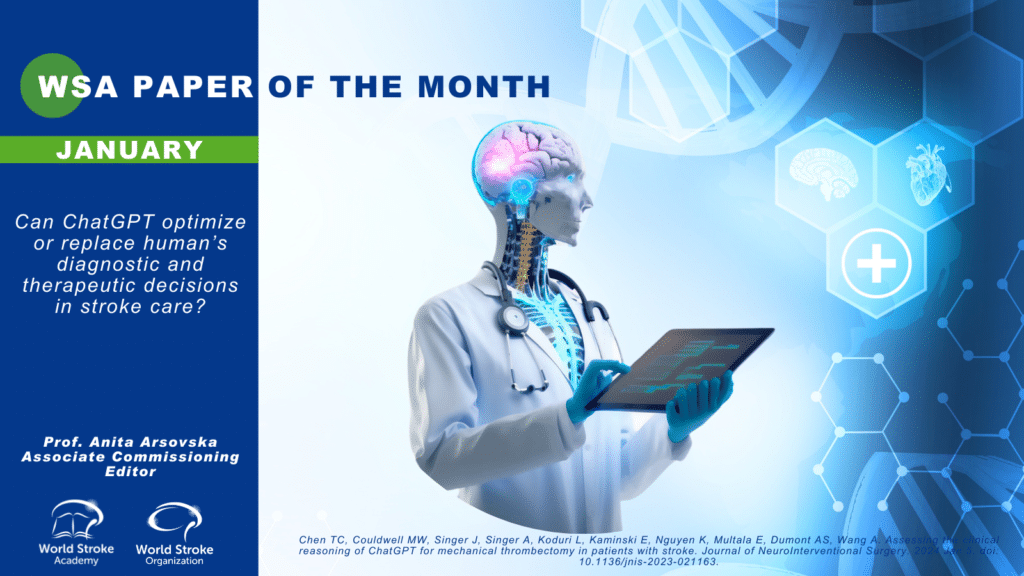The Paper of The Month – January
19 Jan 2024Title: Can ChatGPT optimize or replace human’s diagnostic and therapeutic decisions in stroke care?

Title: Can ChatGPT optimize or replace human’s diagnostic and therapeutic decisions in stroke care?
Author: Prof. Dr. Anita Arsovska – WSA Associate Commissioning Editor
This article is a commentary on the following: Chen TC, Couldwell MW, Singer J, Singer A, Koduri L, Kaminski E, Nguyen K, Multala E, Dumont AS, Wang A. Assessing the clinical reasoning of ChatGPT for mechanical thrombectomy in patients with stroke. Journal of NeuroInterventional Surgery. 2024 Jan 5. (https://pubmed.ncbi.nlm.nih.gov/38184368/)
Summary of the findings
This is the first paper that assessed the potential of ChatGPT (Chat.Openai.com) as a clinical reasoning tool for mechanical thrombectomy (MT) in patients with an acute ischemic stroke. All patients with large vessel occlusions (LVOs) who underwent MT at Tulane Medical Center between January 1, 2022 and December 31, 2022 were included in the study. The performance of ChatGPT in evaluating which patients should undergo MT was compared with the decisions made by board-certified stroke neurologists andneurointerventional radiologists. The interpretation skills, clinical reasoning, and accuracy of ChatGPT were analyzed. A total of 102 patients with LVOs underwent MT. ChatGPT agreed with the physician’s decision whether or not to pursue thrombectomy in 54.3% of the cases. ChatGPT reached erroneous therapeutic choices in 8.8% of the presented cases due to mathematics, logic, and misinterpretation errors. In the internal validation phase, ChatGPT was able to provide nuanced clinical reasoning and was able to perform multi-step thinking, although with an increased rate of making mistakes. The authors conclude that ChatGPT shows promise in clinical reasoning, including the ability to factor a patient’s underlying comorbidities when considering MT. However, ChatGPT is prone to errors as well and should not be relied on as a sole decision-making tool in its present form, but it has potential to assist clinicians with more efficient work flow.
Commentary
ChatGPT (Chat Generative Pre-trained Transformer) is a chatbot developed by OpenAI and launched on November 30, 2022. Based on a large language model, it enables users to refine and steer a conversation towards a desired length, format, style, level of detail, and language (2). One of its key benefits is immediate access to information in a conversational format, which is essential in acute medical conditions. At the moment, medical utilization of ChatGPT is a hot research topic (3).In the field of cerebrovascular diseases, ChatGPT couldhelp early symptoms recognition, provide guidance on immediate responses, and brief users on what to expect during their medical evaluation and treatment processes (3).
Vora and Doshi explored how ChatGPT would inform and guide the general population about a serious condition like ischemic stroke (4). On the positive,ChatGPT provided an explanation ofthe pathophysiology of ischemic stroke and prompt actions with clarity using a simple layperson language. For example: “it is crucial for stroke patients to receive prompt medical attention and be assessed by healthcare professionals for appropriate management,” thereby urging the reader to get act promptly and raising awareness regarding the urgency of ischemic stroke and it gave all possible options for management in a concise manner. On the other hand, ChatGPT didn’t provide references which would question the source and evidence-based of the data; it didn’t state the most important and common risk factor for ischemic stroke (hypertension) and it didn’t mention the time interval (4.5 hours from symptom onset) for which the candidate would be eligible for thrombolytic therapy. This vital information could change the prognosis for patients as it would prompt them more to act in a timely manner.
Lam and Aupublished their experience with the use of ChatGPT in stroke patients (3).They stressed that chatbots, in some sense, are providing telemedicine, which is particularly important in remote or underserved areas. However, if stroke patients are experiencing symptoms of dysphasia, aphasia, or alexia, using Chatbots may be challenging. Seeking help from caregivers, or virtual assistants may be needed. By providing instant responses to patients and their families, these systems may help improving patients’ outcomes by enabling early detection of symptoms and facilitating timely seek of urgent medical attention.
Chlorogiannis et al. have explored the potential application of ChatGPT in cardiovascular and cerebrovascular disease management (5). They concluded that ChatGPT contributes to symptom analysis, supports differential diagnosis, assesses risk factors, collects real-time data, facilitates referral recommendations, educates patients, and enhances telemedicine interactions. By assisting healthcare providers in the diagnostic process, ChatGPT may play a valuable role in the early detection and management of critical medical conditions, ultimately leading to better patient outcomes.
Ruksakulpiwat et al. provideda comprehensive review on use of the Generative Pre-trained Transformer (ChatGPT) in medical research, including but not limited to treatment, diagnosis, or medication provision (6). They identified 114 articles, out of which six studies met the inclusion and exclusion criteria for full-text screening. Among the six studies, two focused on drug development (33.33%), two on literature review writing (33.33%), and one each on medical report improvement, provision of medical information, improving research conduct, data analysis, and personalized medicine (16.67% each).Regarding drug development, the results illustrated that AI algorithms could help speed up new drug development and treatment and identify the side effect and interactions. However, limitations, including ethical issues, pharma confidentiality regarding new drugs under development, must be considered. Regarding the Medical Report Improvement, ChatGPT may be used to simplify (and standardized) radiology reports, although the level of agreement between ChatGPT-reports had some errors, such as missed findings or unspecific locations. Another caveat is the higher level of plagiarism encounter in ChatGPT text and abstracts. Also, ChatGPT did notnot produce original texts after paraphrasing.
How the future would look like using AI in translational medicine?
1) AI can be used in big data analysis, such as electronic medical records and genomic data, to help identify factors causing disease and predict patient outcomes; 2) AI can help develop personalized medicine that is tailored to the specific needs and characteristics of individual patients. However, using ChatGPT in translational medicine presents challenges, such as: 1) algorithms can be biased and incomplete if the training data is biased and incomplete, potentially leading to inaccurate results that could impact patient care and outcomes; 2) AI may not fully understand the biological mechanisms of the human body system, resulting in limitations in providing factors contributing to disease and treatment; and 3) unregulated use of ChatGPT (Chatbots) in patient care which may lead to future healthcare inequalities and impact human life.
Conclusion
ChatGPT has the potential to revolutionize medical research in the diagnosis, management, predicting outcomes, and ameliorate the existing knowledge and knowledge-to-action gaps in medical education (7,8). However, its accuracy, originality, academic integrity, and ethical issues must be thoroughly discussed and improve the regulatory framework before its widespread implementation in clinical research and medical practice (6).
References
- Chen TC, Couldwell MW, Singer J, Singer A, Koduri L, Kaminski E, Nguyen K, Multala E, Dumont AS, Wang A. Assessing the clinical reasoning of ChatGPT for mechanical thrombectomy in patients with stroke. Journal of NeuroInterventional Surgery. 2024 Jan 5.
- Lock S. What is AI chatbot phenomenon ChatGPT and could it replace humans. The Guardian. 2022 Dec 5;5.
- Lam WY, Au SC. Stroke care in the ChatGPT era: Potential use in early symptom recognition. Journal of Acute Disease. 2023 Jun 1;12(3):129-30.
- Vora NN, Doshi PK. Use of ChatGPT in Creating Awareness about Ischemic Stroke. Indian J Community Med. 2023 Jul-Aug;48(4):633-635. doi: 10.4103/ijcm.ijcm_381_23. Epub 2023 Jul 14. PMID: 37662135; PMCID: PMC10470564.
- Chlorogiannis DD, Apostolos A, Chlorogiannis A, Palaiodimos L, Giannakoulas G, Pargaonkar S, Xesfingi S, Kokkinidis DG. The Role of ChatGPT in the Advancement of Diagnosis, Management, and Prognosis of Cardiovascular and Cerebrovascular Disease. InHealthcare 2023 Nov 6 (Vol. 11, No. 21, p. 2906). MDPI.
- Ruksakulpiwat S, Kumar A, Ajibade A. Using ChatGPT in Medical Research: Current Status and Future Directions. Journal of Multidisciplinary Healthcare. 2023 Dec 31:1513-20.
- Saposnik G, Galanos LC, Guerrero R, Casagrande F, Adhamidhis E, Gao MMY, Grupper MF, Arsovska A. The World Stroke Academy: A World Stroke Organization global pathway to improve knowledge in stroke care. Int J Stroke. 2022 Oct;17(8):829-834. doi: 10.1177/17474930221085895. Epub 2022 Mar 10. PMID: 35195047; PMCID: PMC9483194.
- Saposnik G. Understanding social media: how its popularity could be used to advance medical education in stroke care? J Neurol. 2023 Aug;270(8):4096-4102. doi: 10.1007/s00415-023-11743-w. Epub 2023 May 18. PMID: 37202604.
Related Interview

